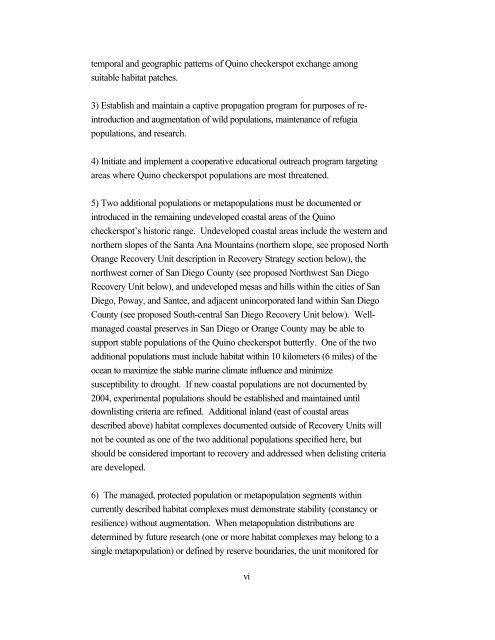Outline of Quino Recovery Plan - The Xerces Society
Outline of Quino Recovery Plan - The Xerces Society
Outline of Quino Recovery Plan - The Xerces Society
You also want an ePaper? Increase the reach of your titles
YUMPU automatically turns print PDFs into web optimized ePapers that Google loves.
temporal and geographic patterns <strong>of</strong> <strong>Quino</strong> checkerspot exchange among<br />
suitable habitat patches.<br />
3) Establish and maintain a captive propagation program for purposes <strong>of</strong> reintroduction<br />
and augmentation <strong>of</strong> wild populations, maintenance <strong>of</strong> refugia<br />
populations, and research.<br />
4) Initiate and implement a cooperative educational outreach program targeting<br />
areas where <strong>Quino</strong> checkerspot populations are most threatened.<br />
5) Two additional populations or metapopulations must be documented or<br />
introduced in the remaining undeveloped coastal areas <strong>of</strong> the <strong>Quino</strong><br />
checkerspot’s historic range. Undeveloped coastal areas include the western and<br />
northern slopes <strong>of</strong> the Santa Ana Mountains (northern slope, see proposed North<br />
Orange <strong>Recovery</strong> Unit description in <strong>Recovery</strong> Strategy section below), the<br />
northwest corner <strong>of</strong> San Diego County (see proposed Northwest San Diego<br />
<strong>Recovery</strong> Unit below), and undeveloped mesas and hills within the cities <strong>of</strong> San<br />
Diego, Poway, and Santee, and adjacent unincorporated land within San Diego<br />
County (see proposed South-central San Diego <strong>Recovery</strong> Unit below). Wellmanaged<br />
coastal preserves in San Diego or Orange County may be able to<br />
support stable populations <strong>of</strong> the <strong>Quino</strong> checkerspot butterfly. One <strong>of</strong> the two<br />
additional populations must include habitat within 10 kilometers (6 miles) <strong>of</strong> the<br />
ocean to maximize the stable marine climate influence and minimize<br />
susceptibility to drought. If new coastal populations are not documented by<br />
2004, experimental populations should be established and maintained until<br />
downlisting criteria are refined. Additional inland (east <strong>of</strong> coastal areas<br />
described above) habitat complexes documented outside <strong>of</strong> <strong>Recovery</strong> Units will<br />
not be counted as one <strong>of</strong> the two additional populations specified here, but<br />
should be considered important to recovery and addressed when delisting criteria<br />
are developed.<br />
6) <strong>The</strong> managed, protected population or metapopulation segments within<br />
currently described habitat complexes must demonstrate stability (constancy or<br />
resilience) without augmentation. When metapopulation distributions are<br />
determined by future research (one or more habitat complexes may belong to a<br />
single metapopulation) or defined by reserve boundaries, the unit monitored for<br />
vi
















